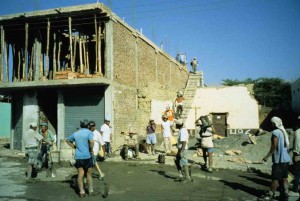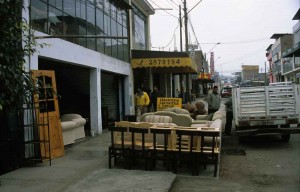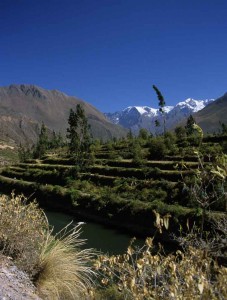Cristine/Ten Thousand Cranes invites you to join in a specially designed trip to Peru and Bolivia this summer. Info is posted in TRAVELS Category. You are welcome to write to: journeys@tenthousandcranes.com
Thank you for your interest in this site. Please note that all images are copyright protected and not available for use without permission. Please contact journeys@tenthousandcranes.com for any inquiries about the information contained in this site.
____________________________________________________________
Shantytowns and Squatters
They abandon mountains or fields for an uncharted journey into a city that doesn’t want them. In post cards, they were the picturesque peasant farmer who gave character to the landscape; in the cities, they are the forgotten, left on their own to reinvent themselves.
In one of history’s largest mass migrations, the rural poor of the developing world are flocking to cities in overwhelming numbers, challenging already failing infrastructures to accommodate millions more hopefuls. With no more lands left for discovery, these are today’s pioneers.
They are converting the world’s mega cities into warrens that are 43% slums; they have each made anguished decisions to abandon the only turf they know and march their families off to an imaginary urban landscape with little more than a pocketful of dreams.
Cities worldwide host intricate tiers of self-constructed living, where vast seas of plastic tarps serve as roofs and rats scurry like household pets through a maze of fumes and cries and stench. Squatters settlements crop up in every imaginable place: in Egypt, squatters have long lived amidst the tombs and chambers of Cairo’s City of the Dead Cemetery; in Latin America and Asia, landfills provide endless opportunity for the newly arrived, as overnight colonies of squatters stake out claims amongst their hopes and the flies; and specifically in Peru, lowland and highland dwellers have settled amidst the chaos of Lima to chase their next meal and mold the dust of the city into futures for their kids. For now, these children will take to the streets, haunting restaurants for meager scraps and begging on corners with tiny brown hands too little to hold all that they need.
In many cities, the less desirable hillsides and beaches find themselves host to the shoeless arrivals whose shanties and shacks then further denude the slopes, inviting the wet-country rains to create a lethal cascade of mud, people, and belongings. Brazil’s Rio de Janeiro has launched urban reforestation programs to prevent such tragedies. Around Lima, the drier, unclaimed land easily finds itself occupied by the scratch-dirt poor who slip into place with pre-dawn stealth.
Lima’s Villa el Salvador
Lying on Lima’s Southern edge, near Pachacamac ruins, a warren of squatter housing evolved into what is today portrayed as an “Oasis of Hope.” Villa el Salvador (VES) was founded in the early 1970’s by an initial wave of 10,000 migrants who either fled from the mountain areas in the wake of an earthquake or fled for their lives from the guns of The Shining Path, the Maoist guerilla group that commandeered parts of Peru in the 1970’s and 1980’s. At present, Villa el Salvador is home to 350,000 people and thrives as an economic hub for both the established and newly arrived.
What emerged like spontaneous combustion in the dry-dirt dust outside Lima was an almost catastrophically large collection of refugees in an inhospitable space. Initially, violence erupted and hundreds starved – the state totally incapable of assisting at a time when it, too, was held hostage by rebels. Taking the reigns into their own toughened hands, these uneducated, peasant farmer transplants evoked the wisdom of their cultural roots and made manifest what millions of squatters have done throughout time: they took responsibility for their own lives.
Pueblo joven - Photo courtesy of Liz Wurster![huaycan2 Pueblo jven [Photo courtesy of Liz Wurster]](https://tenthousandcranes.com/wp-content/uploads/2009/05/huaycan2-300x183.jpg)
Mimicking the management of their own small plots of village land, they divided themselves into smaller units, each a tiny communal democracy within itself. From within that framework, they prioritized tasks, setting goals and standards. In time, they brought order to the proverbial desert, establishing garden plots, sewage control, schools, police cadres, clinics, rehab centers, libraries, a community radio station, etc. Their women were invited into leadership, micro enterprise was launched, and social responsibility became the standard. VES was nominated for a Nobel Peace Prize and received the UN designation of Messenger of Peace. Malnutrition and unemployment still exist in this oasis, for its outer circles are active squatter areas, but never let it be said that the tired bodies of the poor are lazy.
Pueblo joven - Photo courtesy of Liz Wurster![huaycan11 Pueblo joven [Photo courtesy of Liz Wurster]](https://tenthousandcranes.com/wp-content/uploads/2009/05/huaycan11-300x225.jpg)
Pueblo joven - Photo courtesy of Liz Wurster
![huampani2 Pueblo joven [Photo courtesy of Liz Wurster]](https://tenthousandcranes.com/wp-content/uploads/2009/05/huampani2-300x155.jpg)
VES today is still more documentary than tourist brochure and its sounds are more like a radio stuck permanently on “scan.” It is an anthill of life, oozing out on itself. It is both order and chaos. Dirty children and dirtier dogs scavenge through discarded piles of that day’s hope. Men with strong hands chisel furniture to sell while lipsticked ladies in high heels click-clack along streets to other men with different dreams. Commercial sections have long since established themselves into a thriving alternative economy. Shoppers from Lima frequent the more upgraded sections of VES, visiting the typical thematically arrayed streets of the developing world where shoe stores line one street, furniture another, clothing yet another. VES is both the sordid and the sublime. It is a window on the world, testimony to the many forces that move and shape human life.
Peru has only one primate city – Lima, so squatters spread themselves on its edges or on the peripheries of nearby coastal towns. It is both scrabble-dry hillsides and the next adjacent ring that attract new arrivals. In South America, where population numbers don’t present quite the same pressures as in Asia, structures begin more independent of one another, until eventually conjoined into a bustling array of interconnected huts.
When the poor settle on barren land, the first semblances of structure to rise up are several sides of a house, rarely four and commonly pieces of whatever scrap might be found. What has become standard due to a serious lack of scrap wood is a type of woven mat. Making mats for walls has become a small industry in itself. Narrow strips of sliced bamboo from the rainforest are woven into approximately 7- by 12-foot sheets. Staked and laced together, these mats begin to make a house. Eventually a roof is added and as a family finds more success with its street endeavors, mat walls are replaced with adobe or block. Because of Peru’s desert coastal anomaly, rain poses little threat to Lima’s unique mat walls. When cement walls are painstakingly constructed, long sections of rebar are left to protrude upward – prayer flags to the heavens, begging for future growth.
Pueblo joven - Photo courtesy of Liz Wurster![huaycan22 Pueblo joven [Photo courtesy Liz Wurster]](https://tenthousandcranes.com/wp-content/uploads/2009/05/huaycan22-300x183.jpg)
In more established areas, building can be a communal project. Sand, cement, and water are dumped right into the street, mixed by friends with shovels, who then navigate wheelbarrows or buckets up precarious, planked ramps to transport the wet mix to its destination.

Communal building
As I walked an unkempt street, I gazed down a passageway, only to discover that I was looking into someone’s home, created by the two available walls on either side. There was no roof, just a stained blanket suspended over one section of the narrow run of dirt. A bench to one side held a few pans, some onions, and a bucket for water. A sweater hung on a hook, brown, weary, and as slump-shouldered as the person who had recently slipped out of it; the inevitable scrawny dog slept under the bench. Farther back in the shadows was a pile of blankets – probably beds. A broom rested against a wall, a civil statement amidst the poverty. Sidewalks and floors are brushed every morning in Peru, even if they are only dirt.
An old lady, dark skirt and layers of blouses stretched tightly across her chest, stirred a greasy something in a large pan. She sat on a stool, stirring as she must have for decades, the balance of the world in her rhythm. Family members were likely scattered about the community, looking for castoffs, crumbs, or boots needing polished. The lady looked up. I did not take the photo I so wanted to take. Instead, I somehow I let her know I was there as witness, not judge; she did not look away as most do. I stood while she stirred; for seconds la vieja and I were part of the same tapestry.
In 1983, this pueblo jóven (young town, as squatters settlements are called in Peru) was formally established as a district within the greater Lima Province. Today, VES boasts high literacy rates and primary school attendance, lower child mortality rates than the state average, numerous social clubs, large numbers of libraries and schools, and innovative urban planning. It is deeply committed to community endeavor.

Commercial area of VES
Out the window of our departing van, I saw a man on a bicycle, balancing a bamboo mat on his head. I smiled, privileged to be watching the fruits of human endeavor.


